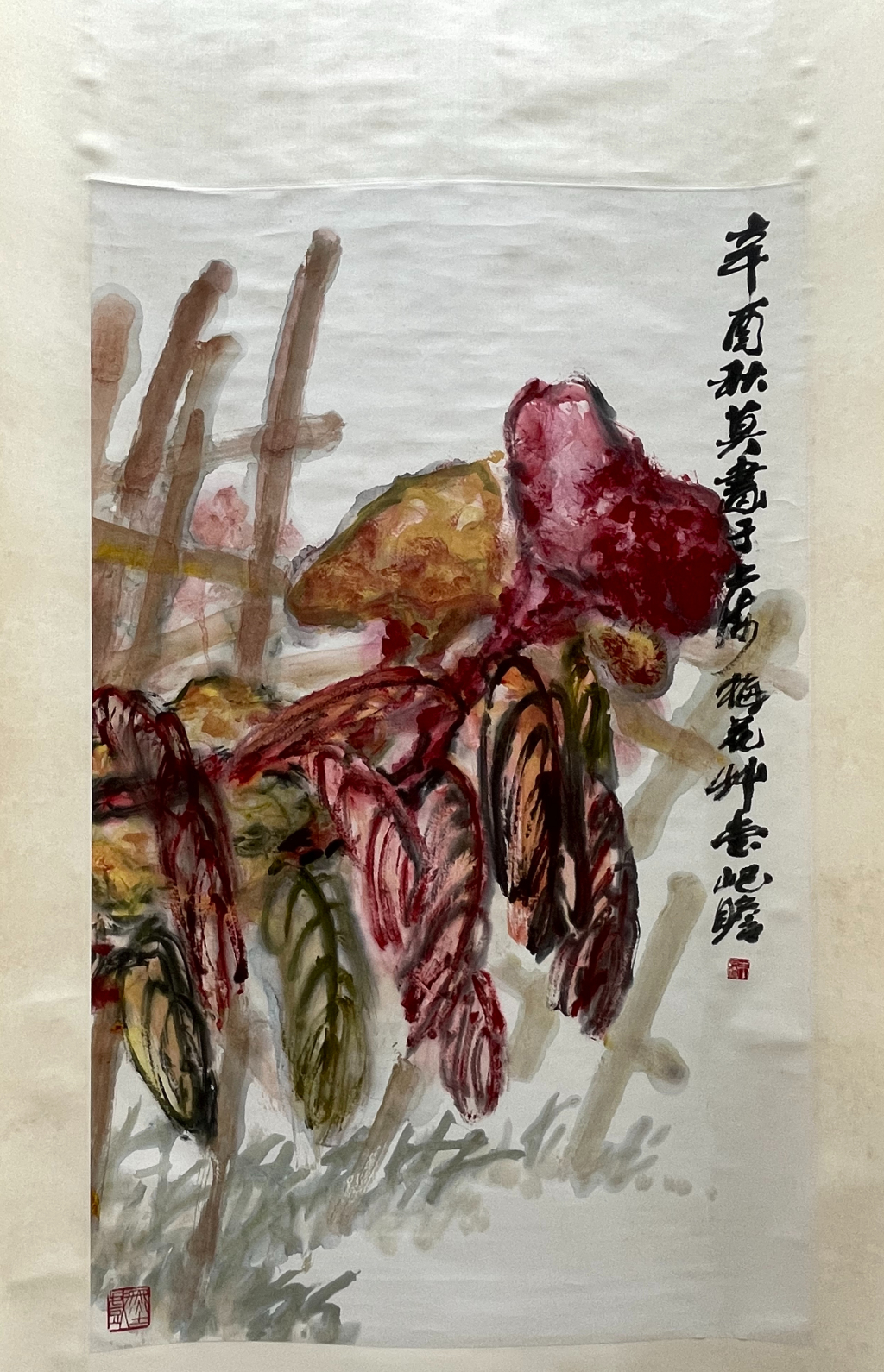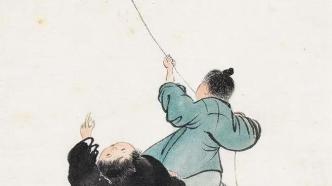
The year 2025 marks the 30th anniversary of the establishment of the Shanghai Zhu Qizhan Art Museum. On June 13, on the eve of the Cultural and Natural Heritage Day, a series of activities themed "Multiple Perspectives" to celebrate the 30th anniversary of the establishment of the Zhu Qizhan Art Museum officially began.
"At the age of 30, come on!" The "AI clone" of Mr. Zhu Qizhan (1892-1996), a master of traditional Chinese painting, waved to the audience at the launch site, as if traveling through time and space to celebrate this special moment together. It is reported that in addition to exhibiting Zhu Qizhan's representative works and documents on the museum's 30 years of establishment, the exhibition also displays the museum's rich collections accumulated in the context of "chronological order" and "academic exhibition", including the masterpieces of Fu Shan, Pu Hua, and modern Qi Baishi, Cai Yuanpei, Chen Shizeng, etc.

Representative works of Zhu Qizhan in his later years on display
In 1995, a public art museum named after the painter Zhu Qizhan was built and opened near Luxun Park in Hongkou District. Over the past 30 years, the Zhu Qizhan Art Museum has always adhered to the academic positioning of "traditional innovation, modern classics and contemporary vision", becoming an artistic business card of Shanghai.
The "Multiple Perspectives - Zhu Qizhan Art Museum's 30th Anniversary Series of Activities" launched this time include "Chronology: Zhu Qizhan Art Research Exhibition", "Genealogy: Zhu Qizhan Art Museum's 30th Anniversary Document Exhibition", "Transliteration: Modern and Contemporary Art History Research and Contemporary Curating" seminar and "Sharing: I Listen to Stories in the Art Museum" workshop.

Photos of Mr. Zhu Qizhan (first from left) at the exhibition

The exhibited Chinese paintings by Zhu Qizhan and Cheng Shifa
Zhu Qizhan Art Research Exhibition: Recreating the “Changes of Eighty Years”
"The modern culture of Hongkou is about a hundred years old." Culture is the negative of Hongkou, on which culture has been written in various forms. The Academy of Fine Arts, the Woodcut Institute, the former residences of celebrities, art galleries, and museums are both the ideal sustenance of culture and the manifestation of its material form.
Mr. Zhu Qizhan (1892-1996), born in Liuhe, Taicang, Jiangsu, was a famous Chinese painter and art educator in the 20th century. He lived in Hongkou in his later years. The combination of Chinese and Western styles is a very important feature of his artistic language. In the second half of his life, he turned his main energy to the study and creation of Chinese painting. The later he got, the better his painting became. When he was nearly 90 years old, he realized the "late reform" in art.
The exhibition "Chronology: Zhu Qizhan Art Research Exhibition" mainly focuses on Zhu Qizhan's representative works before and after the "Law of Eighty Years", studying his artistic exploration and creative characteristics in different contexts in different periods. After 30 years of repeated efforts, the art museum has also moved from "studying Zhu Qizhan" to "studying Zhu Qizhan". The continuous value of Zhu Qizhan's research and its endless ideological resources have become the driving force for the Zhu Qizhan Art Museum to seek its own development.
According to Ma Yan, deputy director of Zhu Qizhan Art Museum, for this research exhibition, the academic team mobilized all forces and resources to search for and borrow Zhu Qizhan's masterpieces from the society. The exhibition displays 22 groups (68 pieces) of works, the main highlights of which include the twelve paintings of "Floating Small Writings", an important representative work completed by Zhu Qizhan in early 1977, which opened the prelude to the "change of eighty years". This work, which combines philosophical thinking and artistic imagery, was called "elegant, vigorous, profound, and beyond the painting. It cannot be done without a broad mind and exquisite art." Zhu Qizhan once wrote before his death: "I have indeed longed to write about the 'subtlety' of life and death. I have never thought of expressing the 'vagueness' of infinite time and space. I recently made twelve paintings of "Floating Small Writings", which can be seen as my attempt at two 'senses of the universe'."

Zhu Qizhan, "Imagination in Small Writing", No. 1. Color on paper, 1977
Zhu Qizhan's "Black Orchid Scroll", which was exhibited publicly for the first time, also attracted much attention. This work, created about 50 years ago, is a 20-meter long scroll provided by Yin Guanghua, the painter and author of "Chronicle of Zhu Qizhan". In the picture, black orchids grow freely, with flowers in full bloom or in bud, and branches and leaves crisscrossed, full of vitality. Zhu Qizhan used bold brushstrokes and unique ink method to show the charm of wild orchids vividly, reflecting an unrestrained yet delicate, vigorous and smart artistic style. It is worth mentioning that there are inscriptions on the picture by artists such as Li Keran, Huang Miaozi, Huang Yongyu, Xu Bangda, and Li Kuchan, which are extremely rare.

Exhibition site of "Ink Orchid Scroll"

Detail of Zhu Qizhan's "Ink Orchid Scroll"

Inscribed by Li Keran at the beginning of Zhu Qizhan's "Ink Orchid Scroll"
30th Anniversary Documentary Exhibition: Wonderful moments in “Genealogy”
The Zhu Qizhan Art Research Exhibition is in contrast to the Zhu Qizhan Art Museum's 30th Anniversary Documentary Exhibition "Genealogy". With a unique perspective and rich content, the exhibition takes the audience through the 30-year history of the Zhu Qizhan Art Museum and showcases its profound accumulation in the field of art.
The Zhu Qizhan Art Museum's 30th Anniversary Document Exhibition is an inward exploration, aiming to fully display the precious materials such as manuscripts, exhibition documents, academic brands, publications, etc. since the opening of the museum through the excavation and sorting of a large amount of basic work and original documents in a visual way.

Documents in the 30th Anniversary Document Exhibition of the Zhu Qizhan Art Museum
Entering the exhibition hall, it is as if time has gone back, and the wonderful moments of the past thirty years emerge one by one. From the preparatory documents in the early days of the museum, the opening ceremony, the creative activities participated by Zhu Qizhan, the posters and leaflets of the exhibitions over the years; from the artists' creative manuscripts to the records of academic seminars, each document carries a memory and witnesses the growth and development of the art museum. Through these documents, you can clearly see the efforts and achievements made by the art museum in academic research, exhibition planning, public education, etc., and feel its efforts to promote the development of art.
Chen Jiu, former curator and artistic director of Zhu Qizhan Art Museum, said that more than 20 years ago, the “New Ink Art Exhibition” and “Opera Figure Painting Exhibition” planned by Zhu Qizhan Art Museum through exploration and research became important exhibition brands. The New Ink Art Exhibition was supported by famous artists such as Chen Jialing, Liu Guosong and Qiu Deshu, who donated a batch of paintings. “Since 2004, Zhu Qizhan Art Museum has been committed to promoting the integration of Chinese opera and ink painting through a series of exhibitions and academic activities. Until now, Hongkou has become a major center for the creation and research of Chinese opera figure painting, and also a cultural benchmark in this field.”

The album of the Zhu Qizhan Art Museum's opera figure paintings exhibition

Detail of Han Yu's painting "Three Monks"
In recent years, Zhu Qizhan Art Museum has evolved from initially focusing on Mr. Zhu Qizhan's personal artistic research to systematically combing through the entire Hongkou art context, including planning documentary exhibitions of Guan Zilan, Lu Dan'an and others, to hosting brand exhibitions such as "Hongkou Appointment with Shenmei". Zhu Qizhan Art Museum has received multi-faceted recognition for its exploration and presentation of modern and contemporary Shanghai art.
Chen Xiejun, former director of the Shanghai Museum, believes that the development of the Zhu Qizhan Art Museum is a vivid epitome of the vigorous development and continuous changes in the Chinese art world and museum industry. From its early exploration to its current efforts and achievements in the field of art, it has witnessed the changes of the times and promoted the development of art.
In addition to displaying the development process of the past 30 years, this exhibition also displays the rich collections accumulated by the art museum in the context of "chronological order" and "academic exhibition". These collections include calligraphy and painting masterpieces by Lin Liang, Fu Shan, Pu Hua in the Ming and Qing Dynasties, as well as modern celebrities such as Qi Baishi, Cai Yuanpei, and Chen Shizeng.

Fu Shan, Running Script, Paper, 194×46cm, Qing Dynasty
"Feathers" by Lin Liang of the Ming Dynasty is painted on silk with colors. The birds in the picture are lifelike with different postures, and the feathers are depicted in detail, showing the exquisite skills of Ming Dynasty court flower and bird paintings; "Running Script Scroll" by Fu Shan, a great calligrapher in the late Ming and early Qing dynasties, is on paper with vigorous brushstrokes and magnificent momentum, reflecting his unique calligraphy style and profound cultural heritage; "Ink Bamboo" by Pu Hua is ink on paper, which outlines the charm of bamboo with simple brushstrokes and expresses the literati's praise for the noble quality of bamboo; "Plum Blossom Cottage" in seal script, which Qi Baishi inscribed to Zhu Qizhan, has vigorous and powerful brushwork, and is thick and wild.

Qi Baishi's seal script inscription "Plum Blossom Cottage" presented to Zhu Qizhan
According to reports, the Zhu Qizhan Art Museum's 30th anniversary series of activities also includes a seminar on "Transposition: Modern and Contemporary Art History Research and Contemporary Curating", which attempts to explore the relationship between research and curating. "Does traditional art need curating? Facing those 20th century arts, how to study, how to curate and exhibit in a contemporary way, where is the link between modern and contemporary?" This series of topics is increasingly worth discussing and exchanging. The seminar will focus on the relationship between research and curating since the museum's 30th anniversary, as well as the construction and shaping of the Zhu Qizhan Art Museum's academic brand, and will exchange and discuss topics such as the exploration of academic brands, how to better visualize academic research, and how to produce knowledge in art museums.

The Zhu Qizhan Art Museum's 30th Anniversary Series of Activities


